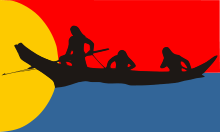Clatsop
| Lā'k!ēlak | |
|---|---|
 Clatsop flag | |
| Total population | |
| 200 | |
| Languages | |
| Chinookan, English, Chinook Jargon | |
| Related ethnic groups | |
| Nehalem (Tillamook) |
The Clatsop are a small tribe of Chinookan-speaking Native Americans in the Pacific Northwest of the United States. In the early 19th century they inhabited an area of the northwestern coast of present-day Oregon from the mouth of the Columbia River south to Tillamook Head, Oregon.
Language
Clatsop in the original language is łät’cαp, which means "place of dried salmon".[1] Clatsop was originally the name of a single settlement, later applied to the tribe as a whole.
The Clatsop dialect used by the tribe is an extinct dialect of the Lower Chinookan language. Most Clatsops spoke Chinook Jargon by the time Lewis and Clark's Corps of Discovery made contact with them.[2] Some spoke Nehalem, reflecting intermarriage and cohabitation with that tribe.
Chinook Jargon is a trade language, and was once used throughout much of the Pacific Northwest. Many place names in the area come from the Chinook Jargon, for example, Ecola Creek and Park — "whale".
History
The tribe is first reported in the 1792 journals of Robert Gray and was later encountered at the mouth of Columbia in 1805 by the Lewis and Clark Expedition. The expedition named their last encampment Fort Clatsop after the tribe, whose nearest major village was approximately 7 miles (11 km) away. The tribe later gave its name to Clatsop County, Oregon. According to the journals of William Clark, the Clatsop comprised about 200 people living in three separate villages of large cedar-plank houses. Clatsop members regularly visited the fort for trading purposes.
The tribe had designated headmen (or "chiefs") but was socially flexible, with individual families affiliating with one another in small villages and seasonal camps located near food sources.
The Clatsop shared salmon, berries, and hunting tips with the Corps of Discovery. In contrast to the Corps' interactions with the Plains Indians the previous winter, their interaction with the Clatsop was more limited. The two groups did not mingle for social occasions and the fort was opened to trading only 24 days during the winter. Part of the reason may have been the existing relationship between the British and the coastal tribes, resulting in a demand by the Clatsop and Chinook for higher prices for their goods at a time when the Corps' supply of "Indian Gifts" had dwindled. Only two Clatsop, Coboway and Cuscalar, appear regularly in the Corps members' journals.
In an 1851 treaty, the Clatsop tribe ceded 90 percent of their land to the U.S. Government. This treaty was one of many in the Northwest that were never ratified by Congress. Unlike other tribes, the members were not required to move to a reservation, and in fact, they were one of the only tribes in Oregon that was the focus of an organized effort to remove tribes to reservations.[3]
The last known speaker of the Tillamook language died in 1972. Individual Clatsop-Nehalem applied for membership with both the Confederated Tribes of Siletz and Confederated Tribes of Grand Ronde but were turned down. In January 2001, the Chinook tribe (of which the Clatsop were included) gained official recognition through an executive order by President Clinton, but this restoration of status specifically excluded the Clatsop members of the Chinook rolls. The Chinook's legal status was reversed by the Bush administration soon after taking office. The bicentennial of the Lewis and Clark Expedition in 2004–2006 provided renewed interest in the status of the Clatsop and Chinook.
The Clatsop have no formal recognition today and have struggled in recent years to retain their identity. Some of the remaining approximately 200 members now form an unofficial confederation, the Clatsop-Nehalem Confederated Tribes of Oregon, with the Salishan-speaking Nehalem (Tillamook) tribe that once inhabited the area around Tillamook Bay. Many Clatsop also remain enrolled with the Chinook Tribe. Other tribes in the region, such as Quinault, Siletz, and Grand Ronde, also have a number enrollees of some partial Clatsop descent. Other Clatsop descendants, unaffiliated, continue to maintain their culture and ceremonies as family and small community units, as in the past.
Museum exhibits
The Tillamook County Pioneer Museum in Tillamook contains exhibits on the history of the Clatsop.
See also
Footnotes
- ↑ (Lā'k!ēlak, "dried salmon", Boas, Franz)
- ↑ (Holton, J. R., Chinook Wawa, 2004)
- ↑ (Dart, Anson. Rolls of Certain Tribes in Oregon and Washington, Ye Galleon Press)
